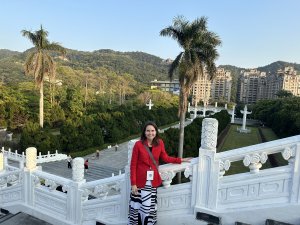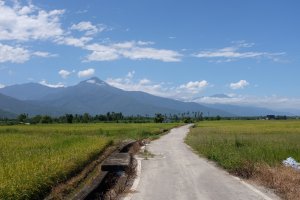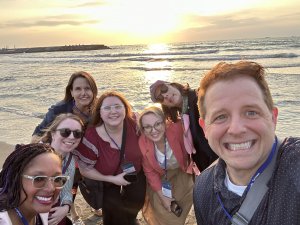My Fulbright Distinguished Awards in Teaching grant led me to Taiwan where I spent four months from January 6 to May 3, 2019 visiting schools, observing classrooms, working with teachers, participating in professional development, teaching a seminar, and learning about the cultures and traditions of the Taiwanese people. These activities were beneficial to my work as an elementary school teacher in a Chinese dual language immersion (DLI) program in Utah (USA). I have gained a better understanding of the teaching and learning practices of the Taiwanese teachers and students, enhanced my teaching and leadership skills, and increased my appreciation for Taiwanese culture and traditions that I can share with my students who are learning Chinese as a second language.
School Visits, Classroom Observations and Working with Teachers
While in Taiwan, I was able to visit an elementary school in Kaohsiung, one in Taipei and another in Taichung. Here I highlighted some of the best practices I have observed in schools in Taiwan, and what I can do to implement them in my own classroom.
| Taiwan Schools (in general) | How I Can Implement in My Classroom | |
| Breaks | Each class period is 40 minutes, followed by a 10-minute break. After two class periods, there is a recess break of 15-20 minutes. For younger grades (grades 1-3), school is usually over after lunch at about noon. For upper grades, Wednesdays are usually a short school day. | I can schedule breaks into my daily class schedules. This will give students time to use the restroom, let their wiggles out, and sharpen their pencils. It will cut down restroom visits and students having to sharpen their pencils during instruction time. |
| Lunch Breaks | Lunch breaks usually last about an hour and 40 minutes. After lunch, students take naps. | I can schedule power nap time into my daily class schedules. |
| Materials | Most, if not all, textbooks and student workbooks are colorful and contain pictures of real places and things rather than cartoons. This is appealing to students, provides authentic learning, and offers great incentive to work on the exercises. | I can use more authentic materials, and format worksheets to make them more appealing and manageable, which will add to differentiation for various types of student learners. |
| Personal Responsibility | Students report to school about an hour before formal classes start to do their school chores such as sweeping up leaves, cleaning windows, classrooms and restrooms. Some also help with lunch deliveries to classrooms. | Currently in my school, we offer a student leadership program for students in grades 4 to 6 to take care of recycling, school announcements, service projects, assemblies, etc. This school leadership program can consider extending service opportunities to the lower grade students, which would encourage responsibility and leadership among more students. |
| Student-Centered Learning | In many of the classes I visited, teachers engaged students in many ways such as group discussions, pair work, peer teaching, movements, learning centers, experiments and seating arrangements that foster cooperative learning. | While I’ve used these in my classroom, I am working on increasing engagement among students and improving the quality of these methods of teaching and learning to meet the varied needs of my students. |
Teaching exchanges in Taiwan allowed me to learn from the teachers, and also to provide feedback at the same time. I have enjoyed sharing teaching strategies that work well in my classroom with colleagues. It has led to deeper friendships with these teachers and increased cooperation between us. We have discussed the possibility of connecting our students, so they could learn each other’s cultures and help one another with their second language acquisition (English for the Taiwan students and Chinese for my US students).
Professional Development
Through attendance at conferences, a teaching seminar, participation on a selection panel for Distinguished Awards candidates from Taiwan, and auditing of two classes at the National Sun Yat-sen University (NSYSU) in Kaohsiung, I have achieved greater professional development. I improved my public speaking skills (how to be prepared, stay calm, etc.), increased my teaching skills, gained analytical skills (for example, how to analyze all aspects when selecting the best candidate) and increased my knowledge of the Taiwanese music through one of the classes I audited, “Taiwanese Music.” Understanding the background of the composers and their impetus for composing helped me to better appreciate the songs that I can share with my students who are learning Chinese.
One of the things I enjoyed most was the teaching seminar for educators and a group of graduate students in the Institute of Education at NSYSU. In that seminar, I shared how the dual language immersion (DLI) program works in Utah, the benefits and challenges of this program, and the pathway to becoming a certified teacher in DLI in Utah. Through pictures of my classes in action, I was able to show examples of how I taught. This gave attendees an idea of how they might be able to customize the Utah model to fit the needs of students and schools in Taiwan as they progress toward an English immersion model by 2030.
Cultural Knowledge
Taiwan is so rich in culture, from food and language to people and places. Being able to personally experience these through living in Taiwan, I can now more effectively share the Taiwanese culture and traditions with my students. Also, through the contacts I have made with educators and friends, I can connect my students more readily with their peers, thus increasing global awareness and understanding, promoting peace and patience, and accepting differences.
Thanks to my Fulbright grant in Taiwan, I have become a better-informed educator. I have learned so much, and shared much, and have felt the urgency to impart my knowledge and experience with my fellow educators back home so that many may benefit from my trip. Without a doubt, I am the one who has experienced the greatest change in many aspects, including my academic and leadership development.
(video) Lay Kou: Integrating Best Practices in Taiwanese Culture of Learning into the American Pedagogy





